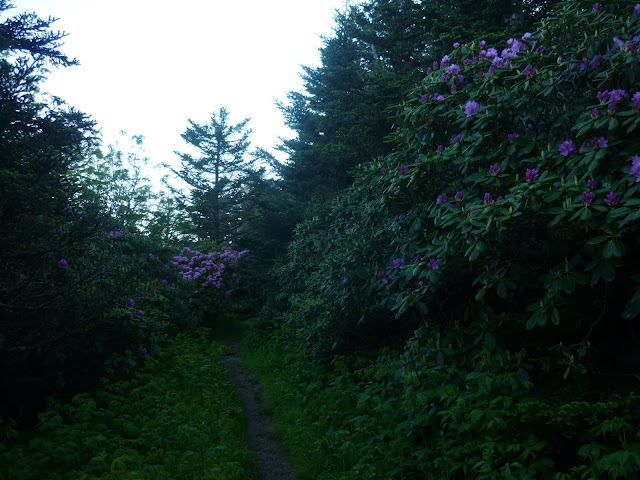Roan has your typical southern Appalachian high ground features; Red Spruce (Picea Rubens), Frasier Fir (Abies Fraseri), Catawba Rhododendron (Rhododendron Catawbiense), American Mountain Ash (Sorbus Americana), some nice open vistas set in a cold climate (things rarely heat up past 70 here), that sort of thing. To someone just passing through from one high point to the next in the region, Roan might not seem to be anything special, but the truth of the matter is that it really does stand alone. For one, Roan really is alone. Most of the surrounding mountains are over a thousand feet lower, if not more than her misty reaches. The result is that the feeling of being "on top of the world" is overwhelming here.
Wide open spaces dominate, with grassy balds affording incredible views of sky and distant land much more readily than places like Mt. Michell or Clingman's Dome, where the summits there actually require viewing platforms to see the forest in spite of the trees. This is probably because Roan is less a true peak than a very high ridge, the end result of which is that even from the dense Spruce-Fir forests, the edge of the world is never far away:
Still, Roan does not attract the same level of attention that the other heights seem to get. This is probably because it is a bit more isolated from the rest of the giant, set back in the backdrop of the Blue Ridge rather than directly along the highest reaches and its celebrated parkway. Her high elevations are rather accessible, being both on the Appalachian Trail and not far from public highways, yet even in the peak of the touring season, my walks through Roan were largely done in solitude. Yes, it was rather late in the day when I finally made my way there, but the crowd of people at the Appalachian trail parking lot 500 feet down from the higher ground indicated that this was not really stopping anyone from having a look at the place. Perhaps part of what makes Roan so quiet, and then too so intimate, was the scale of presentation there.
While Roan is every bit as florid as the other flower hot spots in the region (and rightly so, for the Rhododendrons here are considered to be the finest "gardens" in the world), our friends from the Heath family seemed content to share space with the conifers and ashes. If anything, the ferns give every bit as much of a show as the Catawbas did.
That said, one can not go a few steps in any direction without finding them. They just tend to form a part of the scenery without dominating it:
This is not to say that Rhododendrons are far from being the stars of the show here!
As seen in yesterday's post, they can grow quite large and cover a bit of territory, enough so to contend with the spruces and firs, but like everything else here, they don't tend to dominate so much as they do, say, at Craggy Gardens, which is basically a giant forest of them. You can still stand in a nice thick patch here, surrounded by branches with the flowers over top rather than on your same level, but here they are a part of something more, and more often than not they look as if they are a part of their greater forest portrait. In short, if you want to see Catawba Rhododendrons in their natural setting, you can do so throughout the southern Appalachians, but by and large the best place to see them like this would be at Roan. The Catawbas, you see, can easily make a forest in and of themselves, but they grow best as a friend to the spruces, firs, ashes, and the lovely grasses, sedges, and ferns.
Roan just has a very primordial feeling to it. As I mentioned last post, it feels like a piece of Eden that got left behind for us. Roan is a place of balance, a place of greatness, to be sure:
But also a place of balance, where the young are even more prevalent than the old, and where the attentive eye will notice that the more delicate creations have just as much of an allure to those who come to marvel at the beauty of the created world here:
Roan is very like a religious icon set in the natural world. This place invites one to quiet rambling thoughts and instead look into a natural world that we so often ignore or expect to put on a show for us. This place invites us in to a world that is our home, and yet one we still can be amazed by and curious about. Roan is definitely a place I will explore again and again, as I wish to travel more through its sunny balds and deep spruce-fir forests.




























No comments:
Post a Comment